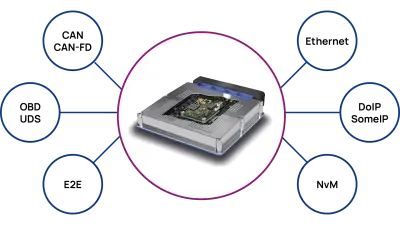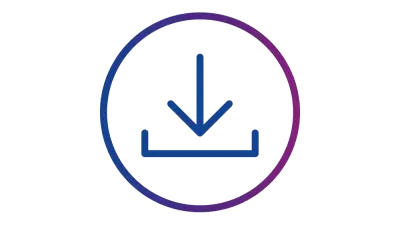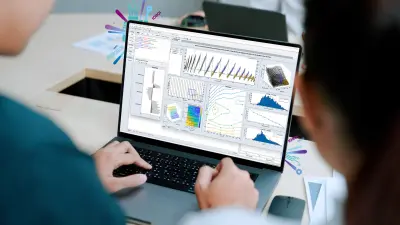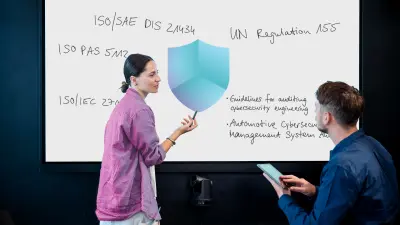AUTOSAR Classic basic software solution
Your ambition is our mission
Your project, your vision
We support you with customized solutions for your AUTOSAR use cases, which are open to any partner system. Choose only the components that are needed for your individual project.
Cost efficient freedom
Pay only for what you use, enjoy competitive prices and benefit from lowered cost per ECU produced
True flexibility
With us, the driver’s seat is yours. Our flexible, vendor-independent vehicle platform software RTA-CAR can be tailored to your exact needs, so that you have full control of your AUTOSAR project.
> 4,000,000,000 ECUs
Strong service, always on your side
Get timely, superior support in your time zone and your language from our global network of regional hubs: Our local experts are always nearby and ready to help, also at your site.

Unlock the power of AUTOSAR multi-core distributions with our white paper!
Multicore processing is no longer the future—it’s the present. But how can you optimize core distribution for maximum efficiency? Our white paper dives into practical strategies for optimizing core distribution, complete with real-world examples for both new and existing multicore systems.
RTA-CAR at a glance
Compact & efficient
Optimized for resource-constrained, low-latency real-time environments.
Safety & security
Complies with industry standards like ISO26262 and ISO/SAE21434, along with MISRA-C & CERT-C guidelines.
Versatile compatibility
Suitable for all ECU types, from smart sensors to vehicle computers, and adaptable for single and multi-OEM projects.
Our solution for your business success
Just as Microsoft Office provides a comprehensive suite of productivity tools, RTA-CAR offers a cohesive set of products designed to work together efficiently. Add-ons and extensions further enhance functionality to meet specific project needs.

Product details
ISOLAR-A is a tool for designing AUTOSAR Classic architectures, systems, and application software.
- Guided design for systems and application software for Classic AUTOSAR.
- Works seamlessly with ISOLAR-B to cover the full AUTOSAR methodology, from system design to ECU configuration for both application and basic software.
- Based on Eclipse and uses the Artop open-source AUTOSAR model framework for easy extensibility.
- Supports AUTOSAR exchange formats, including system, ECU, and diagnostic extract.
- Enables migration of legacy exchange formats such as DBC, Fibex, LDF, ODX, and Excel.
- Scales to huge projects with thousands of configuration elements.
ISOLAR-B is a tool for configuring AUTOSAR basic software and orchestrating the RTA code generator suite.
- Automates basic software configuration from system descriptions.
- Works seamlessly with ISOLAR-A to cover the full AUTOSAR methodology, from system design to ECU configuration for both application and basic software.
- Provides tool-guided support for complex use cases.
- Enables easy configuration updates with incremental diff and merge functions.
- Integrates seamlessly with ISOLAR-A for faster workflows.
- Offers graphical views, like COM stack configurations, for easier project work.
RTA-BSW is a suite of modular code generators that produce AUTOSAR classic runtime software from your ARXML configuration.
- One-box essential development kit: everything you need to build an AUTOSAR classic CAN-based ECU. Just add the OS, RTE & MCAL!
- Extensible to fit your use cases: add-ons for Ethernet (RTA-ETH), FlexRay (RTA-FRAY), J1939 (RTA-J1939), Lin (RTA-LIN) protocol stacks, and security (RTA-SEC, RTA-ETH-SEC).
- Optimized lock-free inter-partition communication solution (XCoreCDD).
- Seamless integration with ETAS hardware security solutions (CycurHSM and CycurSOC) as well as third party security solutions.
- Proven in use: trusted by the biggest OEMs and Tier1s across the globe as the foundation for their ECU applications.
- Compatible with third party microcontroller abstraction layer (MCAL) solutions.
RTA-BSW: Core Stack
| ETAS Product + Add-Ons | AUTOSAR Cluster | AUTOSAR Modules Included |
ETAS Extensions Included (RTA-BSW Add-On: Rba_*) |
|---|---|---|---|
|
ETAS Product + Add-Ons
RTA-BSW
|
AUTOSAR Cluster
Communication
|
AUTOSAR Modules Included
CanIf+, CanNm+, CanSM+, CanTp+, CanTrcv+*, Com+, ComXf, E2EXf, IpduM+, LdCom, Nm, PduR, Xcp
|
ETAS Extensions Included (RTA-BSW Add-On: Rba_*)
Rba_ComStackCdd, Rba_XCoreCdd, rba_Xfrm
|
|
ETAS Product + Add-Ons
|
AUTOSAR Cluster
Diagnostics
|
AUTOSAR Modules Included
Dcm, Dem, Dlt
|
ETAS Extensions Included (RTA-BSW Add-On: Rba_*)
Rba_DemObdBasic (CARB)
|
|
ETAS Product + Add-Ons
|
AUTOSAR Cluster
Global Time
|
AUTOSAR Modules Included
CanTSyn, StbM
|
ETAS Extensions Included (RTA-BSW Add-On: Rba_*) |
|
ETAS Product + Add-Ons
|
AUTOSAR Cluster
Libraries
|
AUTOSAR Modules Included
Bfx, Crc, Efx, E2E, Ifl Ifx, Mfl, Mfx
|
ETAS Extensions Included (RTA-BSW Add-On: Rba_*) |
|
ETAS Product + Add-Ons
|
AUTOSAR Cluster
Memory
|
AUTOSAR Modules Included
Ea, Fee, MemIf, Nvm
|
ETAS Extensions Included (RTA-BSW Add-On: Rba_*)
Rba_EaFs2, Rba_FeeFs1x
|
|
ETAS Product + Add-Ons
|
AUTOSAR Cluster
Mode management
|
AUTOSAR Modules Included
BswM, EcuM
|
ETAS Extensions Included (RTA-BSW Add-On: Rba_*) |
|
ETAS Product + Add-Ons
|
AUTOSAR Cluster
Safety
|
AUTOSAR Modules Included
WdgIf, WdgM
|
ETAS Extensions Included (RTA-BSW Add-On: Rba_*) |
|
ETAS Product + Add-Ons
|
AUTOSAR Cluster
System Services
|
AUTOSAR Modules Included
ComM, Det, Fim
|
ETAS Extensions Included (RTA-BSW Add-On: Rba_*) |
RTA-BSW: Optimal Add-On Stacks
| ETAS Product + Add-Ons | AUTOSAR Cluster | AUTOSAR Modules Included |
ETAS Extensions Included (RTA-BSW Add-On: Rba_*) |
|---|---|---|---|
|
ETAS Product + Add-Ons
+ RTA-ETH
|
AUTOSAR Cluster
Communication
|
AUTOSAR Modules Included
DoIP-, EthIf, EthSM, EthTrcv*, Sd-, SoAd-, SomeIpTp, SomeIpXf, TcpIp- (submodules: rba_EthArp,
rba_EthAutoIp, rba_EthDHCP, rba_EthDHCPv6, rba_EthICMP, rba_EthIPv4, rba_EthIPv6, rba_EthIcmpV6, rba_EthNdp, rba_EthTcp, rba_EthUd), UdpNm- |
ETAS Extensions Included (RTA-BSW Add-On: Rba_*) |
|
ETAS Product + Add-Ons
|
AUTOSAR Cluster
Global Time
|
AUTOSAR Modules Included
EthTSyn
|
ETAS Extensions Included (RTA-BSW Add-On: Rba_*) |
|
ETAS Product + Add-Ons
++ RTA-ETHSEC
|
AUTOSAR Cluster
Communication
|
AUTOSAR Modules Included
TcpIp (submodules: rba_EthAh, rba_EthIke2, rba_EthIPsec, rba_EthTls)
|
ETAS Extensions Included (RTA-BSW Add-On: Rba_*) |
|
ETAS Product + Add-Ons
+ RTA-J1939
|
AUTOSAR Cluster
Communication
|
AUTOSAR Modules Included
J1939Nm+, J1939Rm, J1939Tp
|
ETAS Extensions Included (RTA-BSW Add-On: Rba_*) |
|
ETAS Product + Add-Ons
|
AUTOSAR Cluster
Diagnostics
|
AUTOSAR Modules Included
J1939Dcm
|
ETAS Extensions Included (RTA-BSW Add-On: Rba_*) |
|
ETAS Product + Add-Ons
+ RTA-LIN
|
AUTOSAR Cluster
Communication
|
AUTOSAR Modules Included
LinIf+ (includes LinTp), LinSM-, (LinNM is part of Nm), LinTrcv*
|
ETAS Extensions Included (RTA-BSW Add-On: Rba_*) |
|
ETAS Product + Add-Ons
+ RTA-FRAY
|
AUTOSAR Cluster
Communication
|
AUTOSAR Modules Included
FrIf+, FrNm, FrSM+, FrTp, FrTrcv*
|
ETAS Extensions Included (RTA-BSW Add-On: Rba_*) |
|
ETAS Product + Add-Ons
|
AUTOSAR Cluster
Global Time
|
AUTOSAR Modules Included
FrTSyn
|
ETAS Extensions Included (RTA-BSW Add-On: Rba_*) |
|
ETAS Product + Add-Ons
+ RTA-SEC
|
AUTOSAR Cluster
Communication
|
AUTOSAR Modules Included
SecOC
|
ETAS Extensions Included (RTA-BSW Add-On: Rba_*) |
|
ETAS Product + Add-Ons
|
AUTOSAR Cluster
Crypto
|
AUTOSAR Modules Included
Csm, CryIf, Crypto, KeyM
|
ETAS Extensions Included (RTA-BSW Add-On: Rba_*)
rba_CryptoCCL (for RTA-SWCL)
rba_CryptoHSM (for CycurHSM) rba_CryptoAuSCS (for CycurSoC) |
|
ETAS Product + Add-Ons
|
AUTOSAR Cluster
Security
|
AUTOSAR Modules Included
IdsM
|
ETAS Extensions Included (RTA-BSW Add-On: Rba_*) |
|
ETAS Product + Add-Ons
+ RTA-SWCL
|
AUTOSAR Cluster
N / A
|
AUTOSAR Modules Included
N / A
|
ETAS Extensions Included (RTA-BSW Add-On: Rba_*) |
RTA-OS is the world’s smallest and fastest AUTOSAR OS:
- Delivers best-in-class real-time performance and memory efficiency.
- Supports a huge range of single and multicore microcontrollers.
- Includes a virtual ECU development kit (VRTA) for rapid development without target hardware.
- Excels in RAM-limited environments thanks to its patented single-stack implementation (reducing stack space by 50 to 80%).
- Optional optimized IOC support educes multi-core inter-partition communication by up to 40% compared to the AUTOSAR standard.
Supported µC & SoCs
Renesas
Infineon
|
NXP
ST
SemiDrive
|
Texas Instruments
XILINX
CALTERAH
UHNDER
|
Further µC & SoCs
In development
|
RTA-RTE generates ECU communication infrastructure and real-time scheduling for all application software components and their interfaces between application software and basic software modules.
- Highly optimizing code generator creates low footprint implements that can be up to 50% smaller than competing solutions.
- Fast generation times to accelerate agile workflows.
- AUTOSAR RIPS (RTE Implementation plug-in service) support as standard for custom extensions or legacy solution integration use-cases.
- Accelerated inter-partition communication when used with RTA-OS.
RTA-CAR FSQP provides documentary support to help you argue functional safety when integrating RTA-CAR into your ECU.
- No special “safety version” of RTA-CAR is required – it is built for ISO26262: ASIL-D as standard.
- Safety manuals define best practice integration guidelines and assumptions of use (AoUs) to ease safety argumentation.
- ISO26262 certificates and certificate reports.
- Example tool classification (TCL) reports and guidance.
How to easily integrate the RTA-CAR AUTOSAR Classic stack: From OEM request to ECU software
We're supporting you through the various integration steps. RTA-CAR can be easily integrated in your project for the creation of your functional ECU software.

Complementary solutions
Additional solutions to help you build your ECU
Flash bootloader solution for ECU reprogramming on the assembly line and in-field use, integrating fully with RTA-CAR and AUTOSAR standard MCAL.
- Integrates with RTA-CAR and security solutions like CycurHSM
- Supports UDS re-programming via CAN as standard (via Ethernet or LIN on request)
- General-purpose and OEM-Specific variants available
Full suite of GM Global-B Standard Utility Modules (SUMs)
- Supports VIP22, VIP23, and VIP24 vehicle platforms
- Integrates with RTA-CAR
RTA-HVR is an ECU partitioning solution for micro-controllers with hardware virtualization.
- Partitioning kernel to allocate CPU cores and hardware features to virtual machines
- Support for interrupt virtualization
- Virtual device extension (VDE) mechanism supports peripheral sharing and creation of fully virtual devices (e.g. virtual busses)
- Option to share a CPU core between multiple VMs
RTA-CCM is a Charge communication management solution for V2G applications.
- Developed in collaboration with Alefbits
- Supports ISO15118-2/-20 charge protocol (AC & DC charging, bi-directional power transfer (BPT), external identification (EIM) and Plug’n’Charge billing)
- Supports ISO15118-3 low-level PLC communication (Qualcomm QAC700x, and Lumissil IS32CG5317 in development)
- Integrates seamlessly with RTA-CAR
ETAS works closely with third-party solution providers to ensure that our solutions work smoothly with complimentary solutions. Examples includes (but are not limited to):
- Infineon: ETAS is a reseller of the Infineon MC-ISAR solution
- NXP: ETAS solutions support NXP’s CoreRide platform and integrate smoothly with the RTD and HSE drivers
- RealTek: RealTek’s Ethernet switches driver software integrates seamlessly with ISOLAR-B
- Gliwa: easy integration of the class-leading T1 tool suite brings state-of-the-art timing analysis to RTA-CAR
- Lauterbach: RTA-OS and RTA-HVR provide support to enable multi-core and hypervisor-aware debugging with Lauterbach’s Trace32 solutions




























